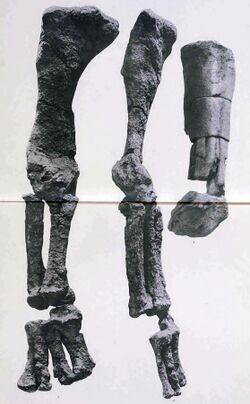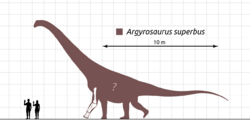Biology:Argyrosaurus
| Argyrosaurus | |
|---|---|

| |
| Holotype forelimb and assigned femur as depicted in 1893 | |
| Scientific classification | |
| Domain: | Eukaryota |
| Kingdom: | Animalia |
| Phylum: | Chordata |
| Clade: | Dinosauria |
| Clade: | Saurischia |
| Clade: | †Sauropodomorpha |
| Clade: | †Sauropoda |
| Clade: | †Macronaria |
| Clade: | †Titanosauria |
| Clade: | †Lithostrotia |
| Genus: | †Argyrosaurus Lydekker, 1893 |
| Species: | †A. superbus
|
| Binomial name | |
| †Argyrosaurus superbus Lydekker, 1893
| |
Argyrosaurus (/ˌɑːrdʒaɪroʊˈsɔːrəs/ AR-jy-roh-SOR-əs) is a genus of titanosaurian sauropod dinosaur that lived about 70 million years ago, during the Late Cretaceous Period of what is now Argentina .
Discovery and naming
The type species, Argyrosaurus superbus, was formally described by Richard Lydekker in 1893.[1]
The holotype specimen of Argyrosaurus superbus is a huge left forelimb, MLP 77-V-29-1. found at Chico River, a Campanian/Maastrichtian horizon in the Lago Colhué Huapi Formation.[2] The material includes the humerus, ulna, radius, and all five metacarpals. Recent stratigraphic information from the Lago Colhue Huapi Formation has the area that the holotype was collected from being a more probable early late Maastrichtian age instead of early Coniacian.[3]
When discovered, the forelimb was apparently a part of a complete skeleton, however, during excavation the rest of the remains were completely destroyed. In the same publication, Lydekker assigned a partial left femur from Chubut Province, MLP 21, to Argyrosaurus but he did not explain his reasoning why he thought the femur was referable to the genus. He also assigned two caudal vertebra centra, MLP 22, from the Santa Cruz Province.[4] After these specimens, other remains were found, including other limb bones, a clavicle, a pubic bone and some tail vertebrae that were referred to the same genus.[4][5][6]
In 1929 Friedrich von Huene referred several specimens to Argyrosaurus; a caudal centrum (DGM [number unknown]) from Chubut Province, three caudal centra MACN 5205 from Santa Cruz Province, a right femur MLP 27 from Neuquén Province, another right femur FMNH 13018 which measures over 2 meters (6.6 ft) long from Chubut Province, a small right humerus MACN 5017 from Neuquén Province, and the distal end of a humerus, half of a radius, and a rib fragment, MMAB [number unknown], from Uruguay.[4]
A complete right femur FMNH 13019 and left tibia FMNH 13020 from Chubut Province were originally referred to Antarctosaurus by Von Huene in 1929, however, in 2003 Jaime Eduardo Powell tentatively referred them to cf. Argyrosaurus.[7][4]
In 1979 Bonaparte and Gasparini referred a partial skeleton, PLV 4628/MACN-CH 217, which included limb material and several vertebrae from Chubut Province to Argyrosaurus.[4][8]
Although these numerous other remains have been referred, in 2012 Philip Mannion and Alejandro Otero considered the holotype remains the only material which unambiguously pertains to the genus. Many of the referred specimens either have no overlapping material, lack key features in the holotype, or were not illustrated making not possible to assign them without being restudied. Most of the referred specimens were considered indeterminate titanosaurs. They also considered one of the referred specimens, the partial skeleton PLV 4628/MACN-CH 217, to be its own genus which they called Elaltitan.[4]
The genus name means 'silver lizard' from Greek argyros, 'silver', and sauros, 'lizard', because it was discovered in Argentina , which literally means 'silver land'. The specific epithet means "proud" in Latin.[9]
Description
Argyrosaurus was a medium-sized sauropod which is estimated to measure 17 metres (56 ft) long and weighing up to 12 tonnes (12 long tons; 13 short tons) according to Paul.[10] However, in 2012 Thomas Holtz gave a higher estimation at 28 metres (92 ft) in length and a possible weight of 43.5-50.8 tonnes (48-56 short tons).[11] More recently it was listed at 21 metres (69 ft) and 26 tonnes (28.6 short tons).[12]
It is distinguished from other genera by the following unique features:[4]
- the medial side of the humerus has a wide ridge that projects forward
- the midshaft of the humerus is extremely compressed
- the width of the distal end of the radius is only slightly greater than the midshaft width
- the radius is subtriangular when viewed from the distal end
- the metacarpals are extremely elongated
References
- ↑ Lydekker, R. (1893). "Contributions to the study of the fossil vertebrates of Argentina. I. The dinosaurs of Patagonia". Anales del Museo de la Plata, Seccion de Paleontologia 2: 1–14.
- ↑ Argyrosaurus in the Paleobiology Database
- ↑ Lucio M. Ibiricu, Gabrieal A. Casal, Ruben D. Martinez, Bruno A. Alvarez, Stephen F. Poropat, (2019). New Materials and an overview of Cretaceous vertebrates from the Chubut Group of the Golfo San Jorge Basin, Central Patagonia, Argentina. Journal of South American Earth Sciences. Vol. 98 [1]
- ↑ 4.0 4.1 4.2 4.3 4.4 4.5 4.6 Mannion, P. D.; Otero, A. (2012). "A reappraisal of the Late Cretaceous Argentinean sauropod dinosaur Argyrosaurus superbus, with a description of a new titanosaur genus". Journal of Vertebrate Paleontology 32 (3): 614–618. doi:10.1080/02724634.2012.660898.
- ↑ Upchurch, Barrett, Dodson; Sauropoda, in The Dinosauria, 2 vol, Weishampel, Dodson, Osmólska, University of California Press, (2004), pag. 259–322, ISBN:0-520-24209-2.
- ↑ Jeffrey A. Wilson, Paul Upchurch, (2003), A Revision of Titanosaurus Lydekker (Dinosauria - Sauropoda), the first dinosaur genus with a 'gondwanan' distribution. Journal of Systematic Palaeontology. Vol. 1, N. 3, pg. 125–160.
- ↑ Powell, Jaime Eduardo; Queen Victoria Museum and Art Gallery (Launceston, Tas.) (2003) (in en). Revision of South American titanosaurid dinosaurs: palaeobiological, palaeobiogeographical and phylogenetic aspects. Launceston, Tas., Australia: Queen Victoria Museum and Art Gallery. OCLC 52391340.
- ↑ Bonaparte, J. F.; Gasparini, Z. B. (1979). "Los sauropodos de los grupos Neuquén y Chubut, y sus relaciones cronologicas". Actas del Congreso Geológico Argentino II: 393–406.
- ↑ Ben Creisler Dinosauria Translation and Pronunciation Guide A
- ↑ Paul, Gregory S. Dinosaurs: A Field Guide. London: A. & C. Black, 2010. Print.
- ↑ Holtz, Thomas R. (2012). "Dinosaurs: The Most Complete, Up-to-Date Encyclopedia for Dinosaur Lovers of All Ages". https://www.geol.umd.edu/~tholtz/dinoappendix/HoltzappendixWinter2011.pdf.
- ↑ Molina-Perez & Larramendi (2020). Dinosaur Facts and Figures: The Sauropods and Other Sauropodomorphs. New Jersey: Princeton University Press. pp. 266.
External links
Wikidata ☰ Q133210 entry
 |



